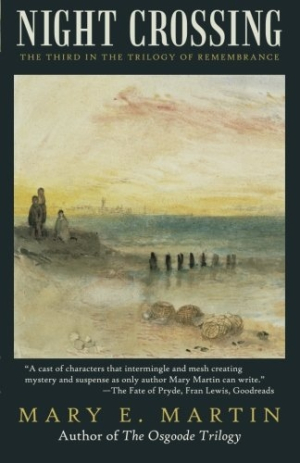Night Crossing
The Third in the Trilogy of Remembrance
A painter spurred on by visions stumbles through life in a novel that offers something for everybody: art, romance, philosophizing, unexpected adventure, and beautiful prose.
In Night Crossing, the final book in the Trilogy of Remembrance, Mary E. Martin paints an enthralling picture of dualities: reality versus illusion, art versus life, love versus work, and free will versus serendipity.
Spurred on by visions of an oval symbolizing the strength and connectedness of all life, British landscape painter Alex Wainwright feels compelled to go wherever his dreams of what he calls “the cosmic egg” lead him. Meanwhile, Alex’s girlfriend, public relations guru Daphne, and his friend-cum-enemy, provocative performance artist Rinaldo, vie for Alex’s attention while he is on his voyage of discovery. Alex’s friend, an art dealer/government employee named James, who also knows Rinaldo and Daphne, narrates the story as if the reader is an acquaintance.
James himself, though, narrates very little of the novel from the first person. Instead, Martin opts for an ingenious third-person omniscient perspective, alternating among Alex’s, Rinaldo’s, and Daphne’s viewpoints. Because he is narrating past events and knows each character intimately, the third-person paragraphs function well as representing James’s knowledge of the players. When James speaks in the first person, he does so charmingly: “Perhaps, by now, you are wondering who is speaking to you? If we happened to meet … [you might] think I’m a drab and dreary soul. … I do like to foster this impression. … But to the observant, the twinkle in my eye will dispel any sense of ennui.”
Because James pieces together this account of several months in Alex’s life, the result is not a story with a traditional beginning, middle, and end, but rather a deft invitation from the author, by way of James, to observe the intertwining lives of the players. Martin’s lyrical prose, apt similes and metaphors, and unexpected turns of events entrance as each major character learns and grows. Alex, gifted enough to paint scenes that not only evoke emotion but also express it, struggles to balance the imaginary and the real. In doing so, he affects his relationship with Daphne. By the book’s end, she realizes her true feelings for her beau. Rinaldo, a strident man whose goal is astonishment, softens a bit.
The characters’ journeys interweave like threads as they face a shipwreck, elderly people weighed down by secrets, a stalker, and public humiliation. The novel offers something for everybody: art, romance, philosophizing, unexpected adventure, and beautiful prose. Night Crossing shines as a stand-alone book, although reading the other two installments of the trilogy is strongly recommended.
Reviewed by
Jill Allen
Disclosure: This article is not an endorsement, but a review. The publisher of this book provided free copies of the book and paid a small fee to have their book reviewed by a professional reviewer. Foreword Reviews and Clarion Reviews make no guarantee that the publisher will receive a positive review. Foreword Magazine, Inc. is disclosing this in accordance with the Federal Trade Commission’s 16 CFR, Part 255.

